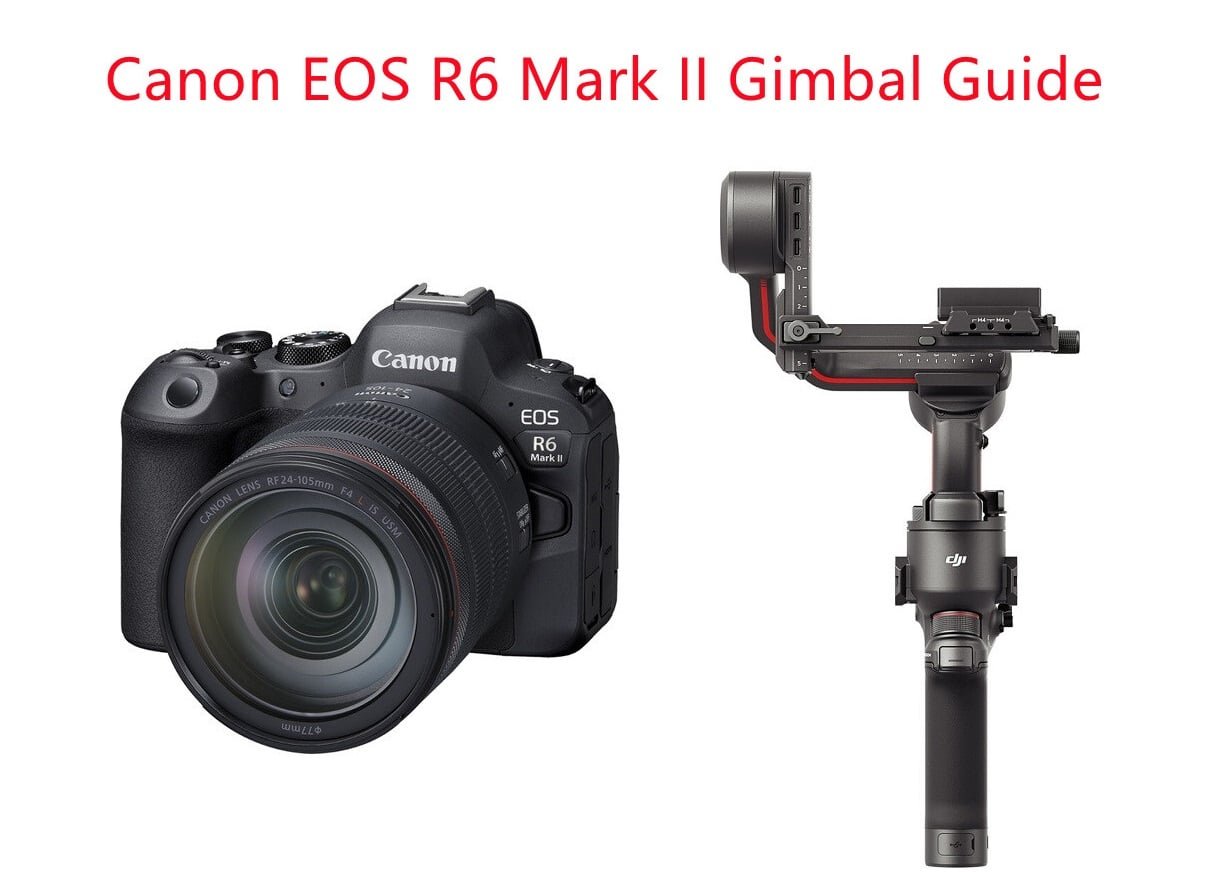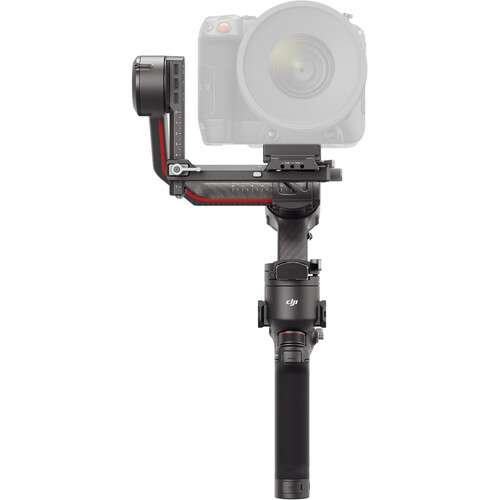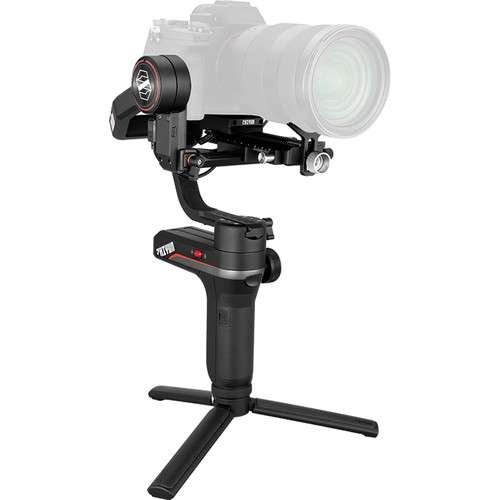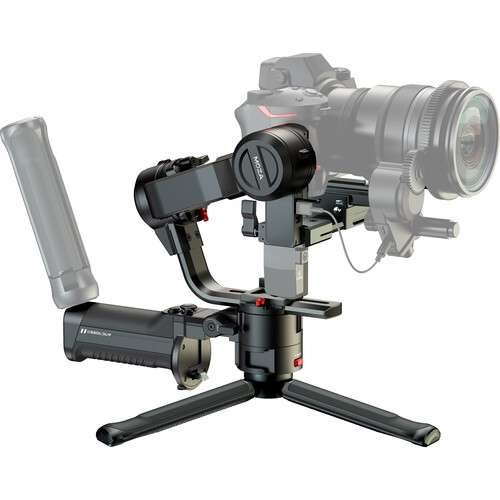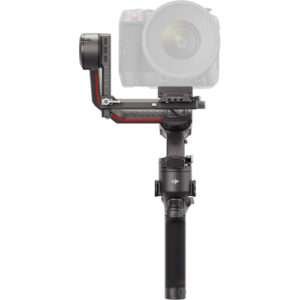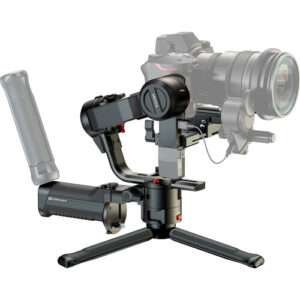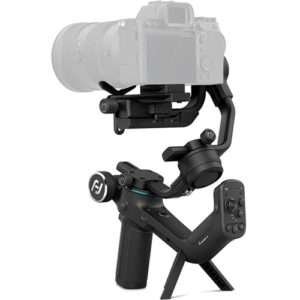Best Gimbals for Canon EOS R6 Mark II
The Canon EOS R6 Mark II boasts an updated 24.2MP Full-Frame CMOS sensor, 40 fps continuous shooting, UHD 4K 60p 10-Bit internal video recording, and more, making it a high-performance hybrid camera that’s perfect for various photography subjects, including professional production, vlogging, filmmaking, portrait, landscape, sports, and wildlife. However, to fully harness the potential of this exceptional camera, you need to use a high-quality gimbal that can provide the necessary stability and smoothness for your shots. But with so many gimbal options available in the market, selecting the ideal one for your specific needs can be daunting.
Fortunately, we’ve taken the guesswork out of the equation and curated a comprehensive list of the best gimbals for Canon EOS R6 Mark II. Our selection features gimbals that have undergone rigorous research and testing, ensuring optimal performance, durability, and ease of use. We have considered various aspects, such as maximum payload capacity, battery runtime, charging time, weight, connection types, display screens, and smartphone app compatibility, to give you a well-rounded selection. In the detailed reviews that follow, we provide an in-depth analysis of each gimbal, highlighting its advantages and disadvantages, so you can make an informed decision on which one is the best fit for your photography style.
Whether you’re a seasoned professional photographer or videographer, or just starting out, our recommended list of gimbals for Canon EOS R6 Mark II is guaranteed to elevate your photography and videography game. So, without further ado, let’s dive into the detailed reviews of the best gimbals for Canon EOS R6 Mark II to help you make the best choice for your needs.
Canon EOS R6 Mark II Store Links: B&H, Adorama.
Best Gimbals for Canon EOS R6 Mark II
Based on comprehensive research and personal experience, we have curated a selection of the best gimbals that seamlessly integrate with the Canon EOS R6 Mark II camera. These gimbals have been chosen for their exceptional performance, stability, and adaptability, providing an enhanced videography and photography experience.
Our in-depth reviews provide a comprehensive analysis of each of the recommended gimbals, including their critical features, advantages, and drawbacks. Whether you are a seasoned filmmaker or a beginner, you will discover a gimbal that meets your specific needs and budget.
Image | Product | Features | Price |
| |||
| |||
| |||
| |||
| |||
|
1. DJI RS 3
Best Overall Gimbal
DJI RS 3 Key Features:
- Max. Payload: 6.6 lb / 3 kg
- Battery Runtime: 12 Hours (Removable, 3000 mAh)
- Battery Charging Time: 2.5 Hours (Supports 18W PD Fast-charging)
- Connections: Bluetooth 5.0, USB-C
- Display: 1.8-inch OLED Touchscreen
- Smartphone App: Yes
- Compatiblitle Cameras: Click Here to Check
- Weight: 2.2 lb / 990 g
- Dimensions: 410 x 260 x 195 mm
- Warranty: 1 year
- Special Feature: 3rd-Gen RS Stabilization Algorithm, Instant Mode Switching, Supports Wireless Image Transmitter, Motion Control with Smartphone, PD Fast Charging, Multiple Operation Modes, Fine-Tuning Knob on Tilt Axis, Wireless Shutter Control, Lots of accessories
As a professional videographer and photographer, I have been using the DJI RS 3 gimbal with my Canon EOS R6 Mark II for several months now, and I must say that it has exceeded my expectations. The DJI RS 3 is, without a doubt, the best overall gimbal for the Canon EOS R6 Mark II on the market.
The DJI RS 3 is an advanced gimbal that is designed for professional use. It has a maximum payload of 6.6 lbs (3 kg), which is more than enough to support my Canon EOS R6 Mark II with various lenses and accessories attached. The gimbal is lightweight, weighing in at just 2.2 lbs (990 g), which makes it easy to carry around and use for extended periods of time.
One of the standout features of the DJI RS 3 is its advanced 1.8-inch OLED touchscreen, which allows you to control the gimbal and access its various settings with ease. The touchscreen is highly responsive and easy to navigate, and it displays all of the essential information you need to operate the gimbal. The DJI RS 3 also supports wireless image transmission, which is incredibly helpful when you need to see what the camera is seeing in real-time.
The DJI RS 3 is equipped with an advanced 3rd-gen RS stabilization algorithm, which provides incredibly smooth and stable footage. This is essential for capturing professional-quality video, and the DJI RS 3 delivers exceptional results. It also has instant mode switching, which allows you to switch between various operation modes with ease. The gimbal also has a customizable front dial and Bluetooth shutter button, which makes it easy to control your camera without having to touch it.
The DJI RS 3 is also incredibly versatile, with multiple operation modes, a fine-tuning knob on the tilt axis, and wireless shutter control. It has a quick-release design, which makes it easy to switch between different setups and configurations. Additionally, the gimbal has a 12-hour operating time and supports fast charging, which is essential when you need to use it for extended periods of time.
There are some limitations to the DJI RS 3, however. Long lenses may not fit on the gimbal, which can be a problem for some photographers and videographers. However, for most users, this is not an issue, and the DJI RS 3 is an exceptional choice for stabilizing your Canon EOS R6 Mark II.
Overall, I highly recommend the DJI RS 3 gimbal for the Canon EOS R6 Mark II. It offers exceptional stabilization, advanced features, and a highly intuitive user interface. It is an excellent choice for professional videographers and photographers who need a reliable and versatile gimbal for their Canon EOS R6 Mark II.
Pros
- 1.8-inch OLED Color touchscreen
- Up to 3 kg payload
- Beyond Smooth
- Instant Mode Switching
- Customizable Front Dial
- Bluetooth shutter button
- Stabilizes full-frame systems
- Wireless and integrated controls
- Quick-Release Design
- 12-Hour Operating Time + Fast Charging
Cons
- Long lenses may not fit
DJI RS 3 Gimbal Stabilizer at B&H, Adorama.
DJI RS 3 Gimbal Stabilizer Combo at B&H, Adorama.
2. DJI RS 3 Mini
A Lightweight Gimbal for Mirrorless Cameras
DJI RS 3 Mini Key Features:
- Max. Payload: 2 kg (4.4 ls)
- Battery Runtime: 10 Hours
- Battery Charging Time: 2.5 Hours
- Battery Capacity: 2450 mAh / 17.64 Wh
- Display: 1.4″ Full Color Touchscreen
- Smartphone App: Yes
- Compatiblitle Cameras: Click Here to Check
- Folded size: 323 x 195 x 98 mm
- Weight: 1.9 lb / 850 g (with Camera Plate)
- Warranty: 1 year
- Special Feature: 3rd Gen RS Stabilization Algorithm, Wireless Camera Control via Bluetooth, Horizontal & Vertical Modes, Panorama, Timelapse & Tracking Functions, NATO Rail for Handles & Accessories, Includes Extended Grip/Tripod
The DJI RS 3 Mini is a lightweight gimbal designed specifically for mirrorless cameras, including the Canon EOS R6 Mark II. With a maximum payload of 2 kg, the RS 3 Mini can handle professional-grade lenses with ease. As someone who has used this gimbal, I can attest to its smooth performance and ease of use.
One of the standout features of the RS 3 Mini is the 1.4″ full-color touchscreen, which allows for easy navigation of the menu and settings. The color display makes it easy to see what’s going on even in bright sunlight, and the touch interface is responsive and intuitive. I particularly appreciate the ability to switch between landscape and portrait video mode with ease, making it a breeze to capture video in any orientation.
The RS 3 Mini’s 3rd Gen RS Stabilization Algorithm is incredibly powerful and provides exceptional stabilization even in challenging conditions. I was particularly impressed by how well it handles walking shots, as it almost completely eliminates any unwanted movement.
Another useful feature of the RS 3 Mini is the ability to wirelessly control the camera via Bluetooth using the DJI app on your smartphone. This allows for even more precise control over the camera and gimbal, and it is particularly useful when capturing shots from a distance or in hard-to-reach locations.
The RS 3 Mini also comes equipped with panorama, timelapse, and tracking functions, which are essential for any serious videographer. The NATO rail makes it easy to attach handles and accessories, and the included extended grip/tripod provides added stability and versatility.
While the RS 3 Mini does have a lot of advantages, there are a few drawbacks to keep in mind. For example, swing-out LCDs may be blocked when shooting in portrait mode, which can be inconvenient. Additionally, the accessory system is not as robust as the bigger DJI RS 3, which can limit the ways in which you can customize your setup.
Overall, I would highly recommend the DJI RS 3 Mini to anyone in need of a lightweight, high-performance gimbal for their mirrorless camera, particularly the Canon EOS R6 Mark II. Its excellent stabilization, easy-to-use interface, and wireless camera control make it a fantastic choice for both amateur and professional videographers.
Pros
- 2kg payload allows for pro lenses
- Color touch display menu
- Easy setup for landscape and portrait video
- Powered stabilization
- Arca-Swiss mounting plate
- Bluetooth camera control link
Cons
- Swing-out LCDs blocked in portrait mode
- Accessory system not as robust as bigger RS 3
- Smartphone activation required
- Doesn’t include onboard video light
DJI RS 3 Mini Gimbal Stabilizer at B&H, Adorama.
3. DJI RS 3 Pro
High Payload Capacity, Most High-end Gimbal
DJI RS 3 Pro Key Features:
- Max. Payload: 9.9 lb / 4.5 kg
- Battery Runtime: 12 Hours (Removable, 1950 mAh)
- Battery Charging Time: 1.5 Hours (24W Fast-charging (QC 2.0 or PD))
- Connections: Bluetooth 5.0, USB-C
- Display: 1.8-inch OLED Touchscreen
- Smartphone App: Yes
- Compatiblitle Cameras: Click Here to Check
- Weight: 2.5 lb / 1143 g
- Dimensions: 415 x 218 x 195 mm, 276 x 268 x 68 mm (Folded)
- Warranty: 1 year
- Special Feature: LiDAR Focusing System, All-New Focus Motor, Long-Range Wireless Transmission, Extended carbon fiber material, 3rd-Gen RS Stabilization Algorithm, Automated Axis Locks, Wireless Shutter Control, Instant Mode Switching, Monitoring via Smartphone, Lots of accesories
The DJI RS 3 Pro is a professional-level gimbal designed to support a wide range of cameras, including the Canon EOS R6 Mark II. With a maximum payload of 9.9 lb (4.5 kg), the RS 3 Pro can support even the heaviest of camera setups. In this review, we’ll take a closer look at the key features and our own experience with this high-end gimbal.
One of the standout features of the RS 3 Pro is its high payload capacity. With a maximum capacity of 9.9 lb (4.5 kg), the gimbal can easily support full-frame camera systems and heavy lenses. This makes it an ideal choice for professional photographers and videographers who need a reliable and sturdy gimbal for their heavy-duty equipment.
Another key feature of the RS 3 Pro is its LiDAR focusing system. This technology enables the gimbal to automatically focus on a subject, providing greater accuracy and stability during filming. This is particularly useful for capturing fast-moving subjects or in low-light conditions.
The RS 3 Pro also features an advanced 1.8-inch OLED touchscreen, which makes it easy to control the gimbal’s settings and adjust parameters such as pan, tilt, and roll. The touchscreen is intuitive and user-friendly, which means that you don’t need to be a professional to get the most out of this high-end gimbal.
One of the other features that we particularly like about the RS 3 Pro is its extended carbon fiber material. This material makes the gimbal more durable and resistant to wear and tear, which is particularly important for professional-level equipment. The gimbal is also designed to be lightweight, weighing only 2.5 lb (1,143 g), which makes it easy to transport and use on location.
We also appreciate the RS 3 Pro’s long battery life, with a runtime of up to 12 hours on a single charge. The gimbal also supports fast charging, which means that you can quickly top up the battery in just 1.5 hours. This is a great feature for professionals who need to keep filming for long periods of time without worrying about running out of battery.
Overall, the DJI RS 3 Pro is a top-of-the-line gimbal that offers a range of advanced features and capabilities. It is ideal for professional photographers and videographers who need a reliable and high-performance gimbal for their heavy equipment. While it comes with a higher price tag than some other gimbals on the market, the features and performance more than justify the cost for serious professionals.
Pros
- Supports up to 4.5kg (10 lbs)
- Active track Pro support and 1.8-inch OLED touch screen
- Long battery life and fast charging
- Huge potential through accessories
- Strongest Carbon Fiber construction
- LiDAR focusing technology compatibility
- High-Bright Remote Monitoring
- Intuitive and user-friendly control
Cons
- Priced for pros
- Some accessories are equally expensive
DJI RS 3 Pro Gimbal Stabilizer at B&H, Adorama.
DJI RS 3 Pro Gimbal Stabilizer Combo at B&H, Adorama.
4. Zhiyun Weebill 3
Zhiyun Weebill 3 Key Features:
- Max. Payload: 14.33 lb / 6.5 kg
- Battery Runtime: 21 Hours (Non-removable, 2600 mAh)
- Battery Charging Time: 2 Hours (Supports PD Fast charging – USB-C Input)
- Connections: Bluetooth 5.0, USB-C
- Display: 0.96-inch OLED Touchscreen
- Smartphone App: Yes
- Compatiblitle Cameras: Click Here to Check
- Dimensions: 342 x 206.5 x 72.5 mm (Folded)
- Weight: 2.4 lb / 1.1 kg
- Warranty: 1 year
- Special Feature: Integrated Microphone and Fill Light, Dual Quick Release Plate System, Two Rosette Mounts with 1/4″-20 Threads, Tripod Extension, Control Wheel, Bluetooth and Wi-Fi Capabilities for App, Lots of Accessories
The Zhiyun Weebill 3 is an excellent gimbal for photographers and videographers looking for a comfortable and highly capable device that can handle heavy camera setups. The Weebill 3 boasts a range of features that make it a top-of-the-line gimbal, including its impressive 14.33 lb payload capacity and long battery life of up to 21 hours.
One of the standout features of the Weebill 3 is its comfortable design. The optimized 2.0 sling structure, extendable sling grip, and wrist rest make it easy to hold for extended periods, making it ideal for shooting long videos or timelapses. The Weebill 3 also comes with a built-in microphone and fill light, which makes it even more versatile.
The Weebill 3 also has a dual quick release plate system, which allows you to switch between camera setups quickly. The two rosette mounts with 1/4″-20 threads and tripod extension make it easy to mount the Weebill 3 on tripods, monopods, or other equipment, which is great for professionals on-the-go. It also has various control cables for DSLR cameras, which makes it a great choice for videographers.
The Weebill 3 is also reasonably priced compared to other high-end gimbals on the market, making it a great value for money. The device’s powerful motor and stabilization work together to provide incredible smoothness and precision in motion, and the control wheel and trigger are easy to use.
However, the small OLED screen can make it challenging to read the menu, and the setup may be confusing for beginners. Additionally, the Weebill 3 doesn’t have a touchscreen or a flip-out screen, which can be a downside for some users.
Overall, the Zhiyun Weebill 3 is an excellent gimbal with a range of features that make it a top contender for those looking for a powerful, versatile, and comfortable device that can handle heavy camera setups.
Pros
- Incredibly comfortable
- Built-in light and microphone
- Super powerful 21 hours battery
- Handles heavy cameras
- Competitively priced
- Ergonomic wrist support
- Cheaper than the competition
- Double plate quick release with magnetic tool
- Powerful motor and stabilization
- Easy trigger and wheel control
- Extended handle grip and wrist support
Cons
- Small OLED screen
- No touchscreen
- No flip-out screen
- Setup was confusing for a beginner
Zhiyun WEEBILL-3 Gimbal Stabilizer at B&H, Adorama.
Zhiyun WEEBILL-3 Gimbal Stabilizer Combo at B&H, Adorama.
5. Moza AirCross 3
Moza AirCross 3 Key Features:
- Max. Payload: 7.1 lb / 3.2 kg
- Battery Runtime: 19 Hours (Non-removable, 3500 mAh)
- Battery Charging Time: 1.4 Hours
- Connections: Bluetooth 5.0, WIFI, USB-C
- Display: OLED Built-in Screen
- Smartphone App: Yes
- Compatiblitle Cameras: Click Here to Check
- Dimensions: 310 x 190 x 170 mm, 270 x 225 x 52 mm (Folded)
- Weight: 2.9 lb / 1.3 kg (without Handlebar)
- Warranty: 1 year
- Special Feature: 4 in 1 convertible design, Axis Locks for Simplified Balancing, Angled motor arm for clear camera view, 3* 1/4 Extension Holes, Manual Position 2.0 & Sports Mode 2.0, Wide Compatibility, Stable Algorithm, One Shutter Button Control for All, Upgraded UI Design, Folds down to size of A4 size paper
The Moza AirCross 3 gimbal is an updated and compact version of its predecessor, the Moza AirCross 2. This gimbal is a great option for content creators who are looking for a high-quality and versatile stabilizer for the Canon EOS R6 Mark II camera.
One of the key features of the Moza AirCross 3 is its 4 in 1 convertible design. This design allows users to quickly switch between different modes such as the sling mode, dual-handle mode, and vertical mode, making it a versatile option for various shooting scenarios. Additionally, the angled motor arm of the gimbal provides a clear view of the camera’s LCD screen, making it easier to monitor the footage.
The Moza AirCross 3 has a maximum payload of 7.1 lb (3.2 kg), making it an ideal option for heavy and large cameras, of course including the Canon EOS R6 Mark II. The gimbal can accommodate the weight of the camera and lens, allowing users to capture stable footage without any shakes or movements.
The battery life of the Moza AirCross 3 is also impressive, lasting up to 19 hours on a single charge. Additionally, the quick charging feature allows users to charge the battery in just 1.4 hours. The Moza AirCross 3 also features an OLED built-in screen for easy monitoring of the gimbal’s settings and status. However, the downside of the battery is that it is non-removable, which means that it cannot be swapped out for a fresh battery.
The Moza AirCross 3 has a sleek and durable metal body design, providing excellent build quality. The axis locks also make it easy to balance the camera on the gimbal, allowing users to quickly and efficiently set up the gimbal. The wide compatibility of the Moza AirCross 3 also makes it a great option for users with a variety of cameras, not just the Canon EOS R6 Mark II.
One downside of the Moza AirCross 3 is its user interface, which could be improved for better usability. Additionally, there is no battery level indicator, which can be a disadvantage for users who want to monitor the gimbal’s battery status. The weight of the gimbal could also be a problem for users with a heavy camera setup, as it weighs 2.9 lb (1.3 kg) without the handlebar.
In summary, the Moza AirCross 3 gimbal is an excellent option for Canon EOS R6 Mark II users who want a versatile, high-quality, and durable gimbal. The 4 in 1 convertible design, angled motor arm, and axis locks make it easy to balance and switch between different modes. The battery life and quick charging feature are impressive, and the wide range of connections allows for seamless connectivity to other devices. Although the user interface could be improved, the Moza AirCross 3 is a great option for content creators who want to capture stable and smooth footage with the Canon EOS R6 Mark II.
Pros
- Great build quality
- 4 in 1 convertible design
- Easy vertical/horizontal mode switch
- Can accommodate large cameras
- Optional Active tracking module
- Enhance battery power and quick charging
- Higher payload and lightest weight
- Straightforward control and handling
Cons
- The user interface could be improved
- No battery level indicator
- Weight could be a problem with a heavy camera
Moza AirCross 3 Gimbal Stabilizer at B&H, Adorama.
6. Feiyu SCORP-C
Affordable Gimbal with excellent performance
Feiyu SCORP-C Key Features:
- Max. Payload: 5.5 lb / 2.5 kg
- Battery Runtime: 13 Hours (Non-removable, 2500 mAh)
- Battery Charging Time: 1.6 Hours
- Connections: Bluetooth, USB-C
- Display: No
- Smartphone App: Yes
- Compatiblitle Cameras: Click Here to Check
- Weight: 2.7 lb / 1.2 kg (with Camera Plate)
- Dimensions: 280.8 x 266.2 x 71.3 mm (Folded), 314.4 x 243.3 x 210.7 mm
- Warranty: 1 year
- Special Feature: Control via Buttons and App, Quick Release Camera Plate, Five Follow Modes for Customized Control, Three 1/4″-20 Mounting Threads, USB Type-C Camera Connections, Macromolecular Resin, Aluminum Alloy, Motorized 3-Axis Gimbal, Folding Aileron Bracket, Various shooting modes on Feiyu SCORP APP, Various Automated Modes
The Feiyu SCORP-C is a budget-friendly gimbal that offers exceptional performance for its price point. Designed to be compatible with various cameras, including the Canon EOS R6 Mark II, this gimbal offers a max payload of 5.5 lbs, making it ideal for lightweight setups.
One of the standout features of the SCORP-C is the quick release camera plate, which makes it easy to switch between different cameras without having to rebalance the gimbal. The balance and setup process is also much easier, thanks to the intuitive design of the SCORP-C.
The underslung grip is also very comfortable, allowing you to use the gimbal for extended periods without experiencing any hand fatigue. The SCORP-C is incredibly stable and smooth, even when you’re moving quickly or walking on uneven terrain.
Battery life is also a strong point for the SCORP-C, with a 13-hour runtime from the non-removable 2500mAh battery. The battery charges quickly as well, taking only 1.6 hours to reach full capacity. However, it’s worth noting that heavier cameras may impact battery life.
The SCORP-C offers five follow modes for customized control, allowing you to fine-tune the gimbal’s response to your movements. It also has three 1/4″-20 mounting threads, giving you plenty of options for mounting accessories to the gimbal.
The SCORP-C has a sleek design, with a combination of macromolecular resin and aluminum alloy for durability. The folding aileron bracket also allows for easy storage and transportation, as the gimbal can be compacted to fit in a bag or backpack.
There is a companion smartphone app for the SCORP-C, but some users report that it needs improvement. The app offers various shooting modes, such as panoramic and time-lapse, as well as automated modes, such as face tracking and object tracking.
Overall, the Feiyu SCORP-C is an excellent choice for anyone looking for an affordable gimbal that still delivers outstanding performance. It’s ideal for those who want to shoot smooth, stable footage without breaking the bank.
Pros
- Balance and setup is far easier
- Underslung grip is comfortable
- Incredibly stable and smooth
- Longer battery runtime with fast charging
- Exceptionally economical
Cons
- Camera life dramatically impacted by weight
- App needs a LOT of work
Feiyu SCORP-C 3-Axis Gimbal Stabilizer at B&H.
Thank you for taking the time to read our recommendations for the best gimbals for the Canon EOS R6 Mark II. We hope that you have found this guide informative and helpful in your search for the perfect gimbal for your needs.
If you have any feedback or additional suggestions for gimbals that we should test, we would love to hear from you. We are always looking to improve our guides and recommendations, and we value your input.
In addition, if you have any personal experiences or insights on any of the gimbals we included in this article, we would love to hear your thoughts. Your feedback can help future readers make informed decisions and select the best gimbal for their needs.
Read more:
- Best Lenses for Canon R6 Mark II
- Best Memory Cards for Canon R6 Mark II
- Best Gimbals for Canon EOS R5
- Best Gimbals for Mirrorless Cameras
- Best Smartphone Gimbals
- Best Cameras for Wedding Photography
